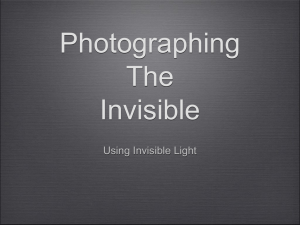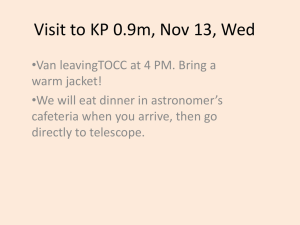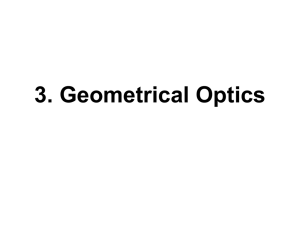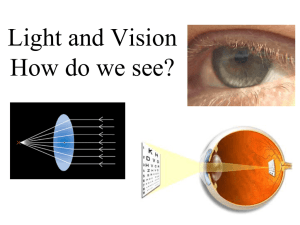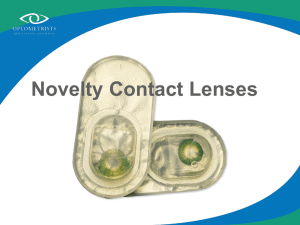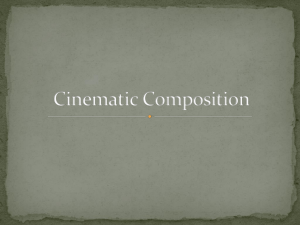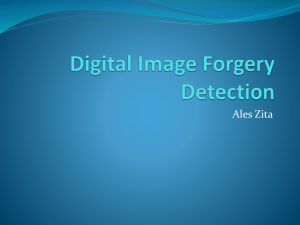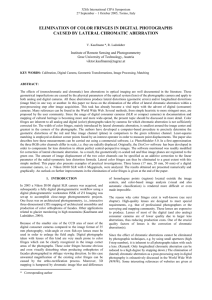Simulating Retinal Images Following Refractive
advertisement
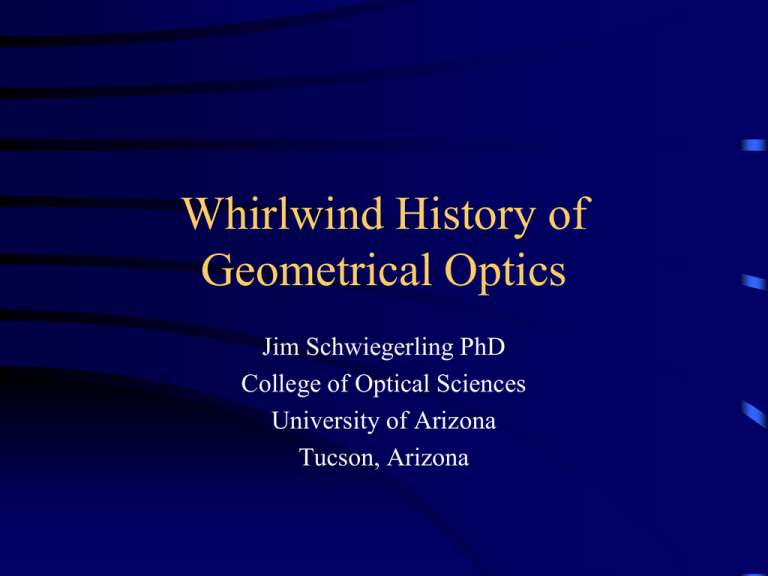
Whirlwind History of Geometrical Optics Jim Schwiegerling PhD College of Optical Sciences University of Arizona Tucson, Arizona Euclid Raphael’s School of Athens Euclid ~300BC • Greek mathematician • His book Elements used to teach geometry for over 2000 years. • Also wrote about optics of the eye, but thought rays exit the eye and we “see” whatever these rays fall on. Archimedes ~250BC • Attributed with a “heat ray” which would focus sunlight onto enemy ships and set them on fire. • Mythbusters “busted” this theory in 2006. Alhazen ~1000AD • Born in modern day Iraq and called the father of modern optics. • His Book of Optics was translated into Latin and later influenced European scholars. • Described magnification in lenses, as well as spherical and parabolic mirrors. • Rays from objects enter the eye. Alhazen - Camera Obscura Visby Lenses ~11-12th Century • Found in modern Sweden. • Possibly used as magnifiers or to start fires. Roger Bacon - 1262AD • English Philosopher and Franciscan Friar. • Studied math, astronomy, optics, alchemy. • Studied the refraction of light by lenses. Spectacle Lenses • Roger Bacon definitely wrote about burning lenses. • He is sometimes attributed with inventing spectacles, but evidence is scarce. • Marco Polo may have seen spectacles in China in 1270. • Italians may have developed spectacles in late 1200s. Fresco by Tommaso da Modena, 1352 Zacharias Janssen ~1590AD • Dutch Spectacle maker • First compound microscope attributed to him in 1590. • First telescope sometimes attributed to him. • Caught counterfeiting coins in 1618. Hans Lipperhay ~1608AD • Dutch Spectacle maker • Next door neighbor of Zacharias Janssen. • First telescope is attributed to him in 1608. • Telescope has positive and negative lens and upright image. Galileo 1609AD • Constructs in 1609 one of Lipperhay’s telescopes. • Father of observational astromnomy. • Observed phases of Venus, sunspots and moons of Jupiter. • Got in trouble for heliocentric views. Johannes Kepler 1611AD • German astronomer • Describes telescopes and microscopes in his book Dioptrics. • Proposes telescope with two positive lenses and upside down image. Willebrord Snellius 1621 • Developed “Snell’s Law” of refraction n1sinq1 = n2sinq2, although Ibn Sahl describes this effect in 984 and by Harriot in 1602 who corresponded with Kepler about it. Pierre de Fermat 1657 • Fermat’s principle says that rays follow paths that take the least amount of time. Modern description is the ray path is stationary. • Can get Snell’s law and the law of reflection directly from this. Isaac Newton • 1666 showed white light is composed of all the colors of the spectrum. • 1668 suggested all reflective telescope to avoid chromatic aberration. Didn’t think lenses could be made to correct chromatic aberration. Chester Moore Hall ~1729 • Developed achromatic doublet, or two lenses that correct chromatic aberration when used together. • Demonstrated telescope with achromatic lenses that corrected chromatic aberration. www.tlc-systems.com John & Peter Dolland 1758 • Patented Achromatic lenses well after Hall’s invention. • Hall used an optician George Bass to fabricate lenses. • Bass told Dolland about the lenses and Dolland was able to reproduce the effect. • John (Father) didn’t enforce the patent, but Peter (son) did after father’s death. Thomas Young • British physician who had significant impact in medicine, vision, mechanics, wave theory of light and even Egyptology. • 1801 Proved light acts like a wave by demonstrating interference. • 1814 Realized a Cartouche represented a name in Hieroglyphics. Augustin-Jean Fresnel • ~1818 Developed the concept for a Fresnel lens for lighthouses which have large aperture and short focal length. • Major impact in areas of wave optics including polarization and diffraction theory. Nicéphore Niépce ~1826 • Developed heliography, earliest known photographic process for recording images in a camera obscura. • Required several days to expose. Louis Daguerre ~1839 • First practical and commercial demonstration of photography. • Worked with Niepce until Niepce died in 1933. • Required several minutes to expose. Carl Friedrich Gauss 1840 • German mathematician • Published Dioptrische Untersuchungen which describes the paraxial or Gaussian theory of optics. • Imaging properties of lenses can be determined by their cardinal points. Death in 1855 Carl Zeiss • German Instrument Maker • Developed high quality microscopes and later camera lenses. Philipp Ludwig von Seidel 1856 • German mathematician • Developed a description of monochromatic aberrations which are a deviation of light rays from the paraxial properties described by Gauss. Ernst Abbe • 1866 Research director at Zeiss Optical Works. • 1868 Developed apochromatic lenses which further reduce chromatic aberration beyond what an achromat is capable of. • 1871 Describes a refractometer for measure index of refraction at various wavelengths. • Abbe sine condition describes requirements to reduce aberrations. Otto Schott 1884 • In conjunction with Carl Zeiss and Ernst Abbe founded what is now Schott glass. • Developed new and novel forms of glass. George Eastman ~1888 • Licensed patents from Peter and David Houston covering various aspects of using rolls of film in a camera. • Started Eastman Kodak company which popularized photography. • Original box camera came pre-loaded with film and the customer returned camera for Kodak to make prints and reload. Thomas Edison 1891 • Developed the Kinetoscope which enable one person at a time to view motion pictures. Louis Lumiere 1895 • First portable motion picture camera, film processing and projection system. Simon Lake 1902 • Developed collapsible submarine periscope. • Earlier submarines had fixed periscopes. • Basic concept goes back to at least 1430s. George Hale 1908 • Developed 60” telescope on Mount Wilson (California). • First light 1908. • Biggest telescope in the world at the time. Oskar Barnack ~1912 • Worked for Leica • Developed portable camera with rolls of film based on Kodak’s 35 mm wide film. • 24 x 36 mm images “35 mm format” • Roll of film as long as he could stretch his arms. • Enlarger & Dark room required. Edwin Land 1947 • Established what would become Polaroid corporation in 1932. • Fabricated sheet polarizers for a variety of applications. • Developed the Land Camera and associated film in 1947 which introduced instant photography giving fully developed print in 60 seconds. Boyle & Smith 1969 • Demonstrated a charged-couple device where charge could be shifted along the surface of a semiconductor to storage capacitors. • Fairchild semiconductor developed the technology into commercial devices. • Kodak developed a digital camera in 1975 based on the Fairchild sensor. (0.01 Mpix). Hubble Telescope • First launched in 1990. • Primary mirror was made incorrectly and had spherical aberration. • Repair mission performed in 1993. • Corrected system now provides some of the most iconic astrophotographs ever captured.
